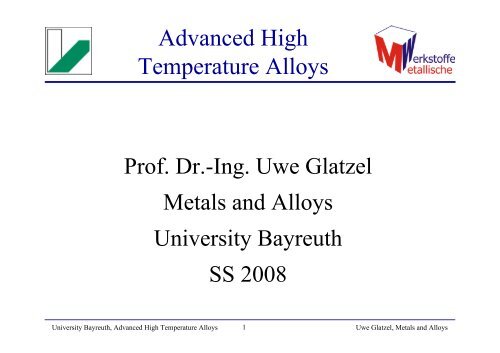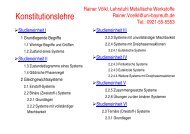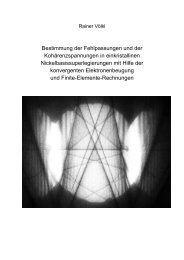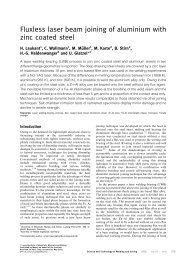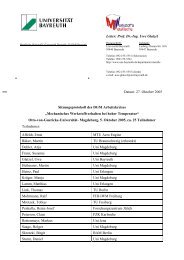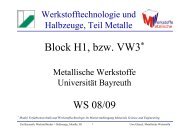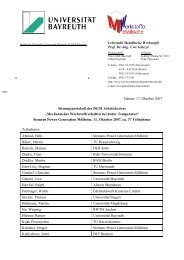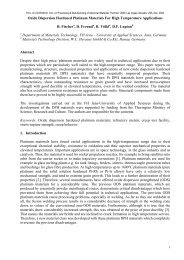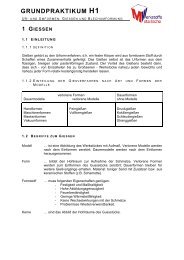Advanced High Temperature Alloys
Advanced High Temperature Alloys
Advanced High Temperature Alloys
You also want an ePaper? Increase the reach of your titles
YUMPU automatically turns print PDFs into web optimized ePapers that Google loves.
<strong>Advanced</strong> <strong>High</strong><br />
<strong>Temperature</strong> <strong>Alloys</strong><br />
Prof. Dr.-Ing. Uwe Glatzel<br />
Metals and <strong>Alloys</strong><br />
University Bayreuth<br />
SS 2008<br />
1<br />
University Bayreuth, <strong>Advanced</strong> <strong>High</strong> <strong>Temperature</strong> <strong>Alloys</strong> Uwe Glatzel, Metals and <strong>Alloys</strong>
Lecturer:<br />
Prof. Dr.-Ing. habil. Uwe Glatzel<br />
• born Dez. 1960<br />
• Physik-Diplom (B.Sc. and M.Sc) in Tübingen<br />
(exchange year in Corvallis, Oregon, USA)<br />
• PhD thesis at the Institute for Metals Research, Technical<br />
University Berlin, Prof. Monika Feller-Kniepmeier<br />
• post-doc (1 Jahr) at Stanford University<br />
• Habilitation TU-Berlin<br />
• Gerhard-Hess award of the German Science Foundation<br />
(DFG) for young scientist (400.000 €)<br />
• 1996-2003 full professor for Metals and <strong>Alloys</strong>, Jena<br />
• since April 2003 Bayreuth (Chair for Metals and <strong>Alloys</strong>)<br />
postal address:<br />
Ludwig-Thoma-Str. 36b phone: +49 (0) 921 - 55-5555<br />
D-95447 Bayreuth, Germany e-mail: uwe.glatzel@uni-bayreuth.de<br />
2<br />
University Bayreuth, <strong>Advanced</strong> <strong>High</strong> <strong>Temperature</strong> <strong>Alloys</strong> Uwe Glatzel, Metals and <strong>Alloys</strong>
Literature<br />
• R. Bürgel, Handbuch Hochtemperatur-Werkstofftechnik, Vieweg<br />
• R.C. Reed, The Superalloys - Fundamentals and Applications, Cambridge Univ. Press<br />
• H. Frost, M. Ashby, Deformation-Mechanism Maps, Pergamon Press<br />
• G. Meetham, M. Van der Voorde, Materials for <strong>High</strong> <strong>Temperature</strong> Engineering<br />
Applications, Springer<br />
• J. Betten, Creep Mechanics, Springer<br />
• Askeland: Materialwissenschaften, Spektrum Lehrbuch; 1994<br />
• Callister: Materials Science and Engineering - An Introduction, Wiley, New York, 1999<br />
• H. Schumann, Metallographie, Deutscher Verlag für Grundstoffindustrie, Leipzig<br />
• F. Vollertsen, S. Vogler, Werkstoffeigenschaften und Mikrostruktur, Hauser Verlag<br />
• P. Haasen, Physikalische Metallkunde, Springer-Verlag, Berlin<br />
• H.-J. Bargel, G. Schulze, Werkstoffkunde, VDI-Verlag, Düsseldorf<br />
• P. Sarrazin, A. Galerie, J. Fouletier, Mechanisms of <strong>High</strong> <strong>Temperature</strong> Corrosion, Trans<br />
Tech Publications<br />
lecture notes: http://www.uni-bayreuth.de/departments/metalle/ then follow "Lehre"<br />
then you will find the link to the lecture notes of this lecture<br />
University Bayreuth, <strong>Advanced</strong> <strong>High</strong> <strong>Temperature</strong> <strong>Alloys</strong> 3<br />
Uwe Glatzel, Metals and <strong>Alloys</strong>
What You Should Know:<br />
• basic thermodynamics<br />
• introduction to diffusion<br />
• introduction to dislocations<br />
• phase diagrams<br />
• theory of elasticity<br />
• ...<br />
• basic materials science courses<br />
4<br />
University Bayreuth, <strong>Advanced</strong> <strong>High</strong> <strong>Temperature</strong> <strong>Alloys</strong> Uwe Glatzel, Metals and <strong>Alloys</strong>
Contents<br />
1. Introduction, Basics<br />
2. Stability of Microstructure<br />
3. Mechanical Properties<br />
a) Static<br />
b) Cyclic (Fatigue)<br />
4. <strong>High</strong> <strong>Temperature</strong> Corrosion<br />
5. <strong>High</strong> <strong>Temperature</strong> <strong>Alloys</strong><br />
6. Lost Wax Investment Casting<br />
5<br />
University Bayreuth, <strong>Advanced</strong> <strong>High</strong> <strong>Temperature</strong> <strong>Alloys</strong> Uwe Glatzel, Metals and <strong>Alloys</strong>
Introduction<br />
• only alloys will be looked at (no ceramics, no<br />
polymers).<br />
• no coatings (BUT in principle: all high<br />
temperature systems are coated!), simply not<br />
enough time.<br />
6<br />
University Bayreuth, <strong>Advanced</strong> <strong>High</strong> <strong>Temperature</strong> <strong>Alloys</strong> Uwe Glatzel, Metals and <strong>Alloys</strong>
Polymer<br />
Glass<br />
Metals<br />
Ceramics<br />
Composits<br />
Maximum <strong>Temperature</strong>s for<br />
Applications of Different Materials<br />
Group<br />
maximum service temperature<br />
[°C]<br />
up to 300<br />
up to 800<br />
Fe-Basis (coated) up to 1100<br />
Fe-ODS up to 1300<br />
Ni-base up to 1200<br />
Pt-base up to 1600<br />
refractory metals in inert<br />
atmosphere above 1600<br />
MoSi 2 up to 1800<br />
SiC up to 1600<br />
(SiC/C) up to 1600<br />
deformation/damage mechanism<br />
melting, decomposing (pyrolyze)<br />
viscous flow<br />
creep, dislocation climb,<br />
grain boundary sliding<br />
viscous flow, glass transition<br />
temperature, grain boundary<br />
sliding<br />
complex<br />
7<br />
University Bayreuth, <strong>Advanced</strong> <strong>High</strong> <strong>Temperature</strong> <strong>Alloys</strong> Uwe Glatzel, Metals and <strong>Alloys</strong>
Nutzbare Festigkeit<br />
Overview Materials<br />
500 Temperatur [°C] 1500 2000<br />
Quelle:<br />
Plansee AG,<br />
Reutte,<br />
Tirol,<br />
Austria<br />
8<br />
University Bayreuth, <strong>Advanced</strong> <strong>High</strong> <strong>Temperature</strong> <strong>Alloys</strong> Uwe Glatzel, Metals and <strong>Alloys</strong>
Nutzbare Festigkeit<br />
Taking Density into Account<br />
500 Temperatur [°C] 1500 2000<br />
9<br />
University Bayreuth, <strong>Advanced</strong> <strong>High</strong> <strong>Temperature</strong> <strong>Alloys</strong> Uwe Glatzel, Metals and <strong>Alloys</strong>
Nutzbare Festigkeit<br />
Oxidation Resistance<br />
500 Temperatur [°C] 1500 2000<br />
10<br />
University Bayreuth, <strong>Advanced</strong> <strong>High</strong> <strong>Temperature</strong> <strong>Alloys</strong> Uwe Glatzel, Metals and <strong>Alloys</strong>
Material Choice<br />
• temperature<br />
• environment<br />
• moving/non-moving part<br />
• design complexity (how to manufacture)<br />
• price constrictions (depending on application<br />
of system). Reduction of 1 kg in weight:<br />
– car ~ 0 - 5 €<br />
– plane ~ 100 – 500 €<br />
– aerospace ~ 100.000 - 500.000 €<br />
11<br />
University Bayreuth, <strong>Advanced</strong> <strong>High</strong> <strong>Temperature</strong> <strong>Alloys</strong> Uwe Glatzel, Metals and <strong>Alloys</strong>
• temperature:<br />
Influence of ... on ...<br />
– phase transitions, volume fractions, ...<br />
– diffusion (� recrystallization, dislocation climb, diffusional creep, ... )<br />
– thermal fatigue (TF)<br />
• mechanical:<br />
– creep<br />
– fatigue (low cycle, LCF, high cycle fatigue, HCF)<br />
• environment:<br />
– oxidation<br />
– corrosion<br />
• combinations:<br />
– thermo-mechanical fatigue (TMF)<br />
– stress corrosion cracking, stress oxidation, ...<br />
12<br />
University Bayreuth, <strong>Advanced</strong> <strong>High</strong> <strong>Temperature</strong> <strong>Alloys</strong> Uwe Glatzel, Metals and <strong>Alloys</strong>
Basics<br />
Boltzmann-statistics: energy of<br />
movement increases with temperature<br />
Thermodynamics ↔ Kinetics<br />
3<br />
u total = 2⋅<br />
u kin = 2⋅<br />
k B ⋅T<br />
= 3⋅<br />
k B ⋅T<br />
atom<br />
atom 2<br />
Utotal mol<br />
= 3⋅<br />
R ⋅T<br />
� 0,33 eV, bzw. 32 kJ/mol bei 1000°C<br />
3<br />
u kin = k B ⋅T<br />
atom 2<br />
ε& = ε&<br />
Q<br />
R T<br />
0 e ⋅<br />
−<br />
⋅<br />
Arrhenius-plot<br />
13<br />
University Bayreuth, <strong>Advanced</strong> <strong>High</strong> <strong>Temperature</strong> <strong>Alloys</strong> Uwe Glatzel, Metals and <strong>Alloys</strong>
c<br />
v<br />
Vacancy Concentration<br />
F = U - T·S � non-zero vacancy concentration is<br />
in thermodynamic equilibrium<br />
=<br />
c v<br />
e<br />
T[°C]<br />
T/T m<br />
Qvac<br />
−<br />
R⋅T<br />
20<br />
0.17<br />
10 -23<br />
Q vac nickel = 1,36 eV (energy necessary to create one vacancy)<br />
300<br />
0.33<br />
3·10 -12<br />
450<br />
0.42<br />
10 -9<br />
800<br />
0.62<br />
10 -6<br />
equilibrium vacancy concentration for nickel<br />
1000<br />
0.74<br />
10 -5<br />
1200<br />
0.85<br />
7·10 -5<br />
1454<br />
1.00<br />
3·10 -4<br />
14<br />
University Bayreuth, <strong>Advanced</strong> <strong>High</strong> <strong>Temperature</strong> <strong>Alloys</strong> Uwe Glatzel, Metals and <strong>Alloys</strong>
Nickel Vacancy Concentration<br />
vacancy concentration<br />
10 0<br />
10 -5<br />
10 -10<br />
10 -15<br />
10 -20<br />
10 -25<br />
Nickel Vacancy Concentration<br />
0 200 400 600 800 1000 1200 1400 1600<br />
temperature [°C]<br />
15<br />
University Bayreuth, <strong>Advanced</strong> <strong>High</strong> <strong>Temperature</strong> <strong>Alloys</strong> Uwe Glatzel, Metals and <strong>Alloys</strong><br />
Tm
J = −D<br />
⋅∇c<br />
vacancy diffusion or<br />
volume diffusion<br />
Diffusion<br />
1. Fick's law<br />
[J] = (atoms) · m -2 ·s -1<br />
[D] = m 2 ·s -1<br />
[c] = (atoms) · m -3<br />
16<br />
University Bayreuth, <strong>Advanced</strong> <strong>High</strong> <strong>Temperature</strong> <strong>Alloys</strong> Uwe Glatzel, Metals and <strong>Alloys</strong>
Qvac Qmigration QSD Coefficient of Diffusion<br />
D<br />
=<br />
energy to create a vacancy<br />
activation energy to migrate a vacancy<br />
activation energy for volume diffusion<br />
Q SD = Q vac + Q migration<br />
D<br />
0<br />
⋅e<br />
−(<br />
Q<br />
vac<br />
+ Q<br />
k⋅T<br />
migration<br />
−Q<br />
k⋅T<br />
Q SD ≈ 17 ·k B ·T m � Q SD nickel ≈ 2.5 eV = 244 kJ/mol<br />
(for a perfect crystal; defects will lower the activation energies)<br />
17<br />
University Bayreuth, <strong>Advanced</strong> <strong>High</strong> <strong>Temperature</strong> <strong>Alloys</strong> Uwe Glatzel, Metals and <strong>Alloys</strong><br />
)<br />
=<br />
D<br />
0<br />
⋅e<br />
SD
Dependence Melting Point and<br />
Enthalpy of Vacancy Creation<br />
element<br />
Pb<br />
Al<br />
Cu<br />
Ag<br />
Ni<br />
Pt<br />
Mo<br />
W<br />
T m<br />
[°C]<br />
327<br />
660<br />
1 085<br />
1 235<br />
1 455<br />
1 768<br />
2 623<br />
3 422<br />
17·R·T m<br />
0.88<br />
1.36<br />
1.99<br />
2.21<br />
2.53<br />
2.98<br />
4.23<br />
5.40<br />
Q vac<br />
[eV]<br />
0.57<br />
0.68<br />
1.29<br />
1.12<br />
1.32<br />
3.00<br />
4.00<br />
crystal<br />
structure<br />
18<br />
University Bayreuth, <strong>Advanced</strong> <strong>High</strong> <strong>Temperature</strong> <strong>Alloys</strong> Uwe Glatzel, Metals and <strong>Alloys</strong><br />
fcc<br />
fcc<br />
fcc<br />
fcc<br />
fcc<br />
fcc<br />
bcc<br />
bcc
Q SD versus T m<br />
400 kJ/mol<br />
0.137 kJ/(mol·K)<br />
≈ 17 · kB ·NA 19<br />
University Bayreuth, <strong>Advanced</strong> <strong>High</strong> <strong>Temperature</strong> <strong>Alloys</strong> Uwe Glatzel, Metals and <strong>Alloys</strong>
Coefficient of Diffusion<br />
Steep slope indicates a<br />
high activation energy.<br />
Small elements diffuse<br />
faster.<br />
Diffusion in fcc crystals<br />
slower than in bcc crystals.<br />
20<br />
University Bayreuth, <strong>Advanced</strong> <strong>High</strong> <strong>Temperature</strong> <strong>Alloys</strong> Uwe Glatzel, Metals and <strong>Alloys</strong>
Coefficient of Diffusion with Defects<br />
Coefficient of diffusion of Th<br />
in W.<br />
Overall velocity for diffusion<br />
depending on grain boundary<br />
thickness, grain size and<br />
dislocation density.<br />
21<br />
University Bayreuth, <strong>Advanced</strong> <strong>High</strong> <strong>Temperature</strong> <strong>Alloys</strong> Uwe Glatzel, Metals and <strong>Alloys</strong>
dashed line:<br />
Pipe Diffusion<br />
diffusion in crystal by the velocity of pipe diffusion<br />
⎛ atoms ⎞<br />
⎜ ⎟<br />
⎝ time ⎠<br />
D eff = D SD + a disl. · ρ ·D disl.<br />
adisl. area of dislocation core<br />
( ≈ 5 b2 ≈ 0.3 nm2 )<br />
ρ dislocation density<br />
Ddisl. pipe diffusion along<br />
dislocation core<br />
atom flux ~ D·area<br />
22<br />
University Bayreuth, <strong>Advanced</strong> <strong>High</strong> <strong>Temperature</strong> <strong>Alloys</strong> Uwe Glatzel, Metals and <strong>Alloys</strong><br />
D<br />
SD<br />
grain<br />
⋅d<br />
~ D<br />
grain<br />
SD<br />
= D<br />
⋅d<br />
2<br />
grain<br />
identical atom fluxes if:<br />
disl.<br />
⋅ b<br />
2<br />
⎛<br />
⎜<br />
⎝<br />
n<br />
⋅<br />
d<br />
grain<br />
atoms ⎞<br />
2<br />
⎟ ~ Ddisl.<br />
⋅b<br />
time ⎠disl.<br />
= D<br />
disl.<br />
⋅ b<br />
2<br />
⋅ρ<br />
⋅n
Grain Boundary Diffusion<br />
dashed line: diffusion in crystal by the velocity<br />
of grain boundary diffusion<br />
D eff = D SD + π · δ / d·D grain bound.<br />
with:<br />
δ effective grain boundary<br />
thickness ( ≈ 2 b ≈ 0.5 nm)<br />
d grain size<br />
Ddisl. pipe diffusion along<br />
dislocation core<br />
23<br />
University Bayreuth, <strong>Advanced</strong> <strong>High</strong> <strong>Temperature</strong> <strong>Alloys</strong> Uwe Glatzel, Metals and <strong>Alloys</strong>
Activation Energies Indicating<br />
Mechanism Changes<br />
~ Q SD<br />
Single crystal aluminium, oriented such that {111} slip is activated.<br />
Lytton, Shepard and Dorn, Trans. AIME 212 (1958) 220<br />
24<br />
University Bayreuth, <strong>Advanced</strong> <strong>High</strong> <strong>Temperature</strong> <strong>Alloys</strong> Uwe Glatzel, Metals and <strong>Alloys</strong>
Diffusion in Ordered Structures<br />
(Intermetallic Phases)<br />
• <strong>High</strong> binding energies � high activation<br />
energies � low coefficient of diffusion<br />
• For example NiAl: very low enthalpy of ordered<br />
B2 structure � low enthalpy outweighs entropy<br />
� ordered up to melting<br />
temperature<br />
T m Ni = 1454°C<br />
T m Al = 660°C<br />
T m NiAl = 1638°C<br />
25<br />
University Bayreuth, <strong>Advanced</strong> <strong>High</strong> <strong>Temperature</strong> <strong>Alloys</strong> Uwe Glatzel, Metals and <strong>Alloys</strong>
∂<br />
∂<br />
c<br />
t<br />
= D⋅<br />
Δc<br />
solution to these<br />
boundary conditions:<br />
Second Fick's Law<br />
Can be concluded directly from first Fick's law.<br />
Similar in heat transfer systems, electrical<br />
potential, ... .<br />
( c − c )<br />
c( x,<br />
t)<br />
= c1<br />
− 1 0<br />
⎛<br />
⋅Γ⎜<br />
⎜<br />
⎝ 2<br />
x ⎞<br />
⎟<br />
D t ⎟<br />
⎠<br />
0.5 1 1.5 2<br />
26<br />
University Bayreuth, <strong>Advanced</strong> <strong>High</strong> <strong>Temperature</strong> <strong>Alloys</strong> Uwe Glatzel, Metals and <strong>Alloys</strong><br />
1<br />
0.8<br />
0.6<br />
0.4<br />
0.2<br />
f 3 (x)<br />
f 2 (x)<br />
f1( x)<br />
f 1 (x)<br />
= 1−<br />
Γ<br />
f2 ( x)<br />
( x)<br />
f3( x)<br />
⎛<br />
= 1−<br />
Γ⎜<br />
⎝<br />
⎛<br />
= 1−<br />
Γ⎜<br />
⎝<br />
x<br />
0.<br />
5<br />
⎞<br />
⎟<br />
⎠<br />
x<br />
0.<br />
05<br />
⎞<br />
⎟<br />
⎠
Thermal Conductivity<br />
Most simple, stationary case: no heat radiation, constant<br />
temperatures in front and back of component.<br />
α heat transfer coefficient<br />
λ coeff. heat conductivity<br />
λ = a · c p · ρ<br />
a coeff. temperature conductivity<br />
c p heat capacity<br />
ρ density<br />
27<br />
University Bayreuth, <strong>Advanced</strong> <strong>High</strong> <strong>Temperature</strong> <strong>Alloys</strong> Uwe Glatzel, Metals and <strong>Alloys</strong>
<strong>Temperature</strong> Distribution with<br />
Thermal Barrrier Coating (TBC)<br />
hot air<br />
cooling air<br />
Wärmedämm- TBC Haftvermittlerschicht bond coat Grundwerkstoff substrate<br />
schicht<br />
28<br />
University Bayreuth, <strong>Advanced</strong> <strong>High</strong> <strong>Temperature</strong> <strong>Alloys</strong> Uwe Glatzel, Metals and <strong>Alloys</strong>
material/property<br />
ferritic steel<br />
austenite steel<br />
Ni-base alloys<br />
Mo<br />
Ti alloys (α-rich)<br />
Al<br />
Al 2 O 3<br />
Thermal Conductivity<br />
λ<br />
⎡ W ⎤<br />
⎢<br />
⎣m<br />
⋅ K ⎥<br />
⎦<br />
45<br />
15<br />
11<br />
145<br />
7<br />
210<br />
25<br />
c p<br />
⎡ J ⎤<br />
⎢ ⎥<br />
⎣kg<br />
⋅ K ⎦<br />
⎡ g ⎤<br />
⎢ 3<br />
⎣cm<br />
⎥<br />
⎦<br />
29<br />
University Bayreuth, <strong>Advanced</strong> <strong>High</strong> <strong>Temperature</strong> <strong>Alloys</strong> Uwe Glatzel, Metals and <strong>Alloys</strong><br />
460<br />
500<br />
450<br />
240<br />
530<br />
890<br />
800<br />
ρ<br />
7.8<br />
8.0<br />
8.2<br />
10.2<br />
4.5<br />
2.7<br />
3.9<br />
⎡ −6<br />
⎢10<br />
⎣<br />
a<br />
m<br />
s<br />
2<br />
⎤<br />
⎥<br />
⎦<br />
13.0<br />
3.8<br />
3.0<br />
59.0<br />
2.9<br />
87.0<br />
8.4
Contents<br />
1. Introduction, Basics<br />
2. Stability of Microstructure<br />
3. Mechanical Properties<br />
a) Static<br />
b) Cyclic (Fatigue)<br />
4. <strong>High</strong> <strong>Temperature</strong> Corrosion<br />
5. <strong>High</strong> <strong>Temperature</strong> <strong>Alloys</strong><br />
6. Lost Wax Investment Casting<br />
30<br />
University Bayreuth, <strong>Advanced</strong> <strong>High</strong> <strong>Temperature</strong> <strong>Alloys</strong> Uwe Glatzel, Metals and <strong>Alloys</strong>
Microstructure is NOT stable<br />
annealed deformed<br />
stress-relieved recrystallized<br />
31<br />
University Bayreuth, <strong>Advanced</strong> <strong>High</strong> <strong>Temperature</strong> <strong>Alloys</strong> Uwe Glatzel, Metals and <strong>Alloys</strong>
Recrystallization<br />
time dependence of<br />
recrystallization can be<br />
approximated by<br />
Avrami-Johnson-Mehl<br />
function:<br />
32<br />
University Bayreuth, <strong>Advanced</strong> <strong>High</strong> <strong>Temperature</strong> <strong>Alloys</strong> Uwe Glatzel, Metals and <strong>Alloys</strong><br />
f<br />
r<br />
=<br />
1−<br />
e<br />
−<br />
⎛<br />
⎜<br />
⎝<br />
t<br />
t0<br />
⎞<br />
⎟<br />
⎠<br />
n
Grain Coarsening<br />
• driving force: reduction of grain boundary<br />
energy<br />
• T > 0.7 · Tm • no pre-deformation necessary<br />
• self-similar system<br />
• Ostwald ripening d ~ t1/3 (big grains eat up<br />
small grains)<br />
• new grains have low dislocation density<br />
33<br />
University Bayreuth, <strong>Advanced</strong> <strong>High</strong> <strong>Temperature</strong> <strong>Alloys</strong> Uwe Glatzel, Metals and <strong>Alloys</strong>
Grain Coarsening<br />
monomodal<br />
bimodal (some grain<br />
boundaries are pinned,<br />
e.g. by precipitates)<br />
34<br />
University Bayreuth, <strong>Advanced</strong> <strong>High</strong> <strong>Temperature</strong> <strong>Alloys</strong> Uwe Glatzel, Metals and <strong>Alloys</strong>
Precipitate Hardening<br />
Requirements:<br />
• solid solution at higher<br />
temperatures (ability to<br />
homogenization heat<br />
treatment)<br />
• during cooling a two-phase<br />
region should be reached<br />
• in general: cooling rate as<br />
high as possible, thereafter<br />
annealing (in the two-phase<br />
region) to let grow the<br />
precipitates<br />
35<br />
University Bayreuth, <strong>Advanced</strong> <strong>High</strong> <strong>Temperature</strong> <strong>Alloys</strong> Uwe Glatzel, Metals and <strong>Alloys</strong>
Thermodynamic ↔ Kinetic<br />
36<br />
University Bayreuth, <strong>Advanced</strong> <strong>High</strong> <strong>Temperature</strong> <strong>Alloys</strong> Uwe Glatzel, Metals and <strong>Alloys</strong>
Example: Al-Cu Alloy<br />
37<br />
University Bayreuth, <strong>Advanced</strong> <strong>High</strong> <strong>Temperature</strong> <strong>Alloys</strong> Uwe Glatzel, Metals and <strong>Alloys</strong>
Time Dependence of<br />
Precipitation Hardening<br />
nucleation, growth, coarsening<br />
d T precipitate size λ T distance between precipitates<br />
f T volume fraction of precipitates<br />
T = const.<br />
38<br />
University Bayreuth, <strong>Advanced</strong> <strong>High</strong> <strong>Temperature</strong> <strong>Alloys</strong> Uwe Glatzel, Metals and <strong>Alloys</strong>
misfit δ<br />
Coherent - Semicoherent - Incoherent<br />
δ<br />
: =<br />
1<br />
2<br />
a<br />
T<br />
− a<br />
( a + a ) a a a<br />
T<br />
M<br />
M<br />
39<br />
University Bayreuth, <strong>Advanced</strong> <strong>High</strong> <strong>Temperature</strong> <strong>Alloys</strong> Uwe Glatzel, Metals and <strong>Alloys</strong><br />
≈<br />
a<br />
T<br />
− a<br />
M<br />
M<br />
≈<br />
a<br />
T<br />
− a<br />
T<br />
M<br />
≈<br />
Δa
Energy Consideration<br />
ΔG total = ΔG vol + ΔG boundary + ΔG strain + ΔG defect<br />
total change in free enthalpy<br />
strain enthalpy (elastic energy + dislocation line energy)<br />
reduction of enthalpy by precipitation coupled with a defect<br />
enthalpy of phase boundary (scales with surface)<br />
enthalpy of formation of matrix to precipitate (scales with volume)<br />
40<br />
University Bayreuth, <strong>Advanced</strong> <strong>High</strong> <strong>Temperature</strong> <strong>Alloys</strong> Uwe Glatzel, Metals and <strong>Alloys</strong>
Heterogeneous Nucleation<br />
41<br />
University Bayreuth, <strong>Advanced</strong> <strong>High</strong> <strong>Temperature</strong> <strong>Alloys</strong> Uwe Glatzel, Metals and <strong>Alloys</strong>
TEM-Micrograph of TiC Precipitates at<br />
Dislocations in an Austenitic Steel<br />
42<br />
University Bayreuth, <strong>Advanced</strong> <strong>High</strong> <strong>Temperature</strong> <strong>Alloys</strong> Uwe Glatzel, Metals and <strong>Alloys</strong>
Ostwald-Ripening of Precipitates<br />
d 3 -d 0 3 ~D⋅t here for T > Tm<br />
γ' particle size in IN 738 LC at<br />
T = 920°C.<br />
particle coarsening constant of<br />
(50 nm) 3 /h<br />
43<br />
University Bayreuth, <strong>Advanced</strong> <strong>High</strong> <strong>Temperature</strong> <strong>Alloys</strong> Uwe Glatzel, Metals and <strong>Alloys</strong>
Contents<br />
1. Introduction, Basics<br />
2. Stability of Microstructure<br />
3. Mechanical Properties<br />
a) Static<br />
b) Cyclic (Fatigue)<br />
4. <strong>High</strong> <strong>Temperature</strong> Corrosion<br />
5. <strong>High</strong> <strong>Temperature</strong> <strong>Alloys</strong><br />
6. Lost Wax Investment Casting<br />
44<br />
University Bayreuth, <strong>Advanced</strong> <strong>High</strong> <strong>Temperature</strong> <strong>Alloys</strong> Uwe Glatzel, Metals and <strong>Alloys</strong>
Room <strong>Temperature</strong> (RT)<br />
<strong>High</strong> <strong>Temperature</strong> (HT)<br />
Deformation<br />
• most alloy properties at room temperature are<br />
time and rate independent (elastic constants,<br />
tension stress, ... ), tension stress experiment.<br />
• For T > 0.4 · Tm the properties (deformation) will<br />
be time and rate dependent, creep experiment.<br />
Kaltverfomung<br />
Kriechen<br />
Verformungsverfestigung<br />
stark<br />
zeitlich begrenzte<br />
Festigkeitssteigerung,<br />
reduziert Zeitstandfestigkeit,<br />
kann Rekristallisation zu<br />
Feinkorn bewirken<br />
Feinkornhärtung<br />
Festigkeitsabnahme bei<br />
feinem Korn<br />
� Grobkorngefüge<br />
erforderlich<br />
mittel bis stark<br />
mittel bis stark<br />
45<br />
University Bayreuth, <strong>Advanced</strong> <strong>High</strong> <strong>Temperature</strong> <strong>Alloys</strong> Uwe Glatzel, Metals and <strong>Alloys</strong><br />
mittel<br />
Mischkristallverfestigung<br />
mittel<br />
Teilchenhärtung<br />
mittel bis stark
Change in Materials Properties<br />
with <strong>Temperature</strong><br />
Material properties of steel and<br />
Ni-alloys at elevated<br />
temperatures. Comparison<br />
between short-term and longterm<br />
parameters.<br />
46<br />
University Bayreuth, <strong>Advanced</strong> <strong>High</strong> <strong>Temperature</strong> <strong>Alloys</strong> Uwe Glatzel, Metals and <strong>Alloys</strong>
shear modulus G<br />
Elastic (E-)Modulus and<br />
Poisson's Ratio<br />
G<br />
=<br />
E<br />
2⋅<br />
( 1+<br />
ν)<br />
47<br />
University Bayreuth, <strong>Advanced</strong> <strong>High</strong> <strong>Temperature</strong> <strong>Alloys</strong> Uwe Glatzel, Metals and <strong>Alloys</strong>
<strong>High</strong> <strong>Temperature</strong> Deformation<br />
• dislocation glide (Peierls stress, in fcc and hcp very small and for T ><br />
0.15 Tm negligible)<br />
• cross slip of screw dislocations and dislocation interactions (for a low<br />
stacking fault energy � larger dislocation spacing � thermal<br />
activation necessary, T > 0.2 Tm , influence on deformation rate)<br />
• climb of edge dislocations to overcome obstacles:<br />
diffusion at complete<br />
dislocation line<br />
� T > 0.4 Tm 48<br />
University Bayreuth, <strong>Advanced</strong> <strong>High</strong> <strong>Temperature</strong> <strong>Alloys</strong> Uwe Glatzel, Metals and <strong>Alloys</strong>
Dislocation Climb<br />
climb of edge dislocations to<br />
annihilate each other.<br />
arrangement in low energy<br />
configurations (sub-grain<br />
boundaries), climbing around<br />
abstacles (leaving the glide<br />
plane)<br />
movement of screw<br />
dislocations with kink<br />
49<br />
University Bayreuth, <strong>Advanced</strong> <strong>High</strong> <strong>Temperature</strong> <strong>Alloys</strong> Uwe Glatzel, Metals and <strong>Alloys</strong>
Back Stress<br />
Dislocations climb allows annihilation of<br />
dislocations and to establish a constant internal<br />
back stress of:<br />
σ = α⋅<br />
G ⋅b<br />
⋅ ρ<br />
σ dislocation = and<br />
i<br />
G ⋅ b 1<br />
⋅<br />
2⋅<br />
π r<br />
G shear modulus, α constant 0.3 - 1, b<br />
magnitude of Burgers vector<br />
50<br />
University Bayreuth, <strong>Advanced</strong> <strong>High</strong> <strong>Temperature</strong> <strong>Alloys</strong> Uwe Glatzel, Metals and <strong>Alloys</strong><br />
ρ<br />
=<br />
1<br />
r
Creep Experiment<br />
behavior of pure metals:<br />
primary secondary tertiary:<br />
51<br />
University Bayreuth, <strong>Advanced</strong> <strong>High</strong> <strong>Temperature</strong> <strong>Alloys</strong> Uwe Glatzel, Metals and <strong>Alloys</strong>
Creep Experimental Setup<br />
up to 1400°C<br />
Constant<br />
temperature<br />
and stress<br />
52<br />
University Bayreuth, <strong>Advanced</strong> <strong>High</strong> <strong>Temperature</strong> <strong>Alloys</strong> Uwe Glatzel, Metals and <strong>Alloys</strong>
Creep Experimental Setup for<br />
Electrical Conductivity Material<br />
up to Melting <strong>Temperature</strong><br />
Pyrometer from left, optical strain<br />
measurement from right, both contact-free.<br />
53<br />
University Bayreuth, <strong>Advanced</strong> <strong>High</strong> <strong>Temperature</strong> <strong>Alloys</strong> Uwe Glatzel, Metals and <strong>Alloys</strong>
strain [%]<br />
7<br />
6<br />
5<br />
4<br />
3<br />
2<br />
1<br />
0<br />
Interrupted creep tests<br />
single crystal (SX) nickel base superalloy (habilitation thesis Glatzel)<br />
strain rate [1/s]<br />
[001] orientation, 1123K, 650MPa<br />
0 10 20 30 40 50 60 70<br />
10 -5<br />
10 -6<br />
10 -7<br />
time [h]<br />
1123K, 650 MPa<br />
[001] orientation, 1123K, 650MPa<br />
0 10 20 30 40 50 60 70<br />
time [h]<br />
0 1 2 3 4 5 6<br />
University Bayreuth, <strong>Advanced</strong> <strong>High</strong><br />
strain<br />
<strong>Temperature</strong><br />
[%]<br />
<strong>Alloys</strong> 54<br />
Uwe Glatzel, Metals and <strong>Alloys</strong><br />
strain rate [1/s]<br />
8x10 -6<br />
6x10 -6<br />
4x10 -6<br />
2x10 -6<br />
0<br />
logarithm of strain rate versus strain<br />
(most valuable information for<br />
materials scientist)
Different Creep Stages<br />
• primary creep: strain rate dε/dt decreases �<br />
material hardens<br />
• secondary creep stage: strain rate constant �<br />
hardening and softening are in equilibrium �<br />
dislocation multiplication and annihilation in<br />
equilibrium � disl. density ρ = const.<br />
• tertiary creep: necking (creep pores) develop<br />
� local stress and strain rate increases<br />
drastically.<br />
55<br />
University Bayreuth, <strong>Advanced</strong> <strong>High</strong> <strong>Temperature</strong> <strong>Alloys</strong> Uwe Glatzel, Metals and <strong>Alloys</strong>
Problem with Low Creep Rates<br />
Life time of stationary gas turbines > 20 years. Assuming a<br />
maximum deformation of 3%, this leads to a strain rate of<br />
about 5·10 -11 s -1 . Reliable data in labs can only be obtained<br />
down to 5·10 -9 s -1 (1 μm change with l 0 = 25 mm after 2 h,<br />
one creep experiment per year!).<br />
Therefore within university labs we are two and more<br />
orders of magnitude too fast than real life in a stationary<br />
gas turbine!<br />
56<br />
University Bayreuth, <strong>Advanced</strong> <strong>High</strong> <strong>Temperature</strong> <strong>Alloys</strong> Uwe Glatzel, Metals and <strong>Alloys</strong>
aw data creep curves:<br />
Engineering Creep Curves<br />
time to failure:<br />
isochrone time to failure:<br />
� time - strain<br />
� isochrone strain<br />
57<br />
University Bayreuth, <strong>Advanced</strong> <strong>High</strong> <strong>Temperature</strong> <strong>Alloys</strong> Uwe Glatzel, Metals and <strong>Alloys</strong>
Tension ↔ Creep Experiment<br />
58<br />
University Bayreuth, <strong>Advanced</strong> <strong>High</strong> <strong>Temperature</strong> <strong>Alloys</strong> Uwe Glatzel, Metals and <strong>Alloys</strong>
ε&<br />
steady state<br />
ρ<br />
≈<br />
⎛<br />
⎜<br />
⎝<br />
Natural Creep Law<br />
= ρ⋅<br />
b ⋅ v<br />
σ<br />
G ⋅ b<br />
v ~ σ<br />
external<br />
⎞<br />
⎟<br />
⎠<br />
1<br />
external<br />
ε&<br />
2<br />
3<br />
σ<br />
G<br />
external ~ 2<br />
� natural creep law<br />
⋅b<br />
59<br />
University Bayreuth, <strong>Advanced</strong> <strong>High</strong> <strong>Temperature</strong> <strong>Alloys</strong> Uwe Glatzel, Metals and <strong>Alloys</strong>
ε&<br />
=<br />
A ⋅σ<br />
Norton Creep Law (Empirical)<br />
n<br />
external<br />
power law break<br />
down (plb)<br />
T = const.<br />
diffusional creep<br />
⋅e<br />
−Q<br />
creep<br />
R⋅T<br />
dislocation<br />
climb<br />
with the Norton creep exponent "n" and<br />
Qcreep ≈ Qself diffusion<br />
stress dependence:<br />
T = const.<br />
60<br />
University Bayreuth, <strong>Advanced</strong> <strong>High</strong> <strong>Temperature</strong> <strong>Alloys</strong> Uwe Glatzel, Metals and <strong>Alloys</strong>
ε&<br />
ε&<br />
Diffusional Creep<br />
• Nabarro-Hering creep (pure volume diffusion)<br />
NH<br />
=<br />
D<br />
self diffusion<br />
2 2<br />
h<br />
σ⋅<br />
Ω<br />
k ⋅T<br />
• Coble creep (grain boundary diff.)<br />
C<br />
=<br />
δ⋅D<br />
grain boundary<br />
2 3<br />
h<br />
σ⋅<br />
Ω<br />
k⋅T<br />
h grain size, δ thickness of grain boundary<br />
61<br />
University Bayreuth, <strong>Advanced</strong> <strong>High</strong> <strong>Temperature</strong> <strong>Alloys</strong> Uwe Glatzel, Metals and <strong>Alloys</strong>
ε& = ε&<br />
+ ε&<br />
diffusion creep<br />
Combined NH and Coble Creep:<br />
NH<br />
C<br />
D<br />
Dself<br />
diffusion Dgrain<br />
boundary D<br />
2 ~ ⋅<br />
2<br />
3<br />
k T h<br />
h kT<br />
h<br />
Ω σ<br />
σ⋅<br />
Ω ⎛ π⋅<br />
δ⋅<br />
⎞<br />
= ⋅ ⋅ ⎜ +<br />
⎟<br />
⋅ ⎝<br />
⎠<br />
eff<br />
=<br />
D<br />
self<br />
diffusion<br />
real geometry (non-cuboidal grains)<br />
+<br />
π⋅<br />
δ⋅<br />
62<br />
University Bayreuth, <strong>Advanced</strong> <strong>High</strong> <strong>Temperature</strong> <strong>Alloys</strong> Uwe Glatzel, Metals and <strong>Alloys</strong><br />
D<br />
grain boundary<br />
h<br />
eff<br />
2
<strong>Temperature</strong> Dependence of<br />
Stationary Creep Rate<br />
σ = 28 MPA = const.<br />
Austenitischer Stahl 800H<br />
fcc alloys:<br />
63<br />
University Bayreuth, <strong>Advanced</strong> <strong>High</strong> <strong>Temperature</strong> <strong>Alloys</strong> Uwe Glatzel, Metals and <strong>Alloys</strong><br />
ε&<br />
s<br />
= A ⋅ γ<br />
3,<br />
5<br />
SF<br />
⎛ σ ⎞<br />
⋅ ⎜ ⎟<br />
⎝ E ⎠<br />
n<br />
⋅ e<br />
−Qc<br />
R⋅T
Activation Energy for Creep<br />
slope = 1<br />
64<br />
University Bayreuth, <strong>Advanced</strong> <strong>High</strong> <strong>Temperature</strong> <strong>Alloys</strong> Uwe Glatzel, Metals and <strong>Alloys</strong>
Constant Load ↔ Constant Stress<br />
n<br />
n<br />
n ⎛ F ⎞ ⎛ F⋅<br />
( 1+<br />
ε)<br />
⎞<br />
ε& = ε&<br />
0 ⋅σ<br />
= ε&<br />
0 ⋅⎜<br />
⎟ = ε&<br />
0 ⋅<br />
= ε0<br />
A ⎜<br />
A ⎟ &<br />
⎝ ⎠<br />
0<br />
failure<br />
ln ε& = ln 0+<br />
n · ln σ0 + n · ln (1+ε) = const. + n · ln (1+ε)<br />
ε&<br />
( ) n<br />
1+<br />
ε<br />
in case the gauge length<br />
deforms uniform with<br />
constant volume<br />
65<br />
University Bayreuth, <strong>Advanced</strong> <strong>High</strong> <strong>Temperature</strong> <strong>Alloys</strong> Uwe Glatzel, Metals and <strong>Alloys</strong><br />
⎝<br />
⎠<br />
⋅σ<br />
As method to determine n only<br />
applicable if secondary creep<br />
state lasts to at least 10%<br />
n<br />
0<br />
⋅
Ashby Deformation<br />
Mechanism Maps<br />
66<br />
University Bayreuth, <strong>Advanced</strong> <strong>High</strong> <strong>Temperature</strong> <strong>Alloys</strong> Uwe Glatzel, Metals and <strong>Alloys</strong>
Ashby Deformation<br />
Mechanism Maps<br />
67<br />
University Bayreuth, <strong>Advanced</strong> <strong>High</strong> <strong>Temperature</strong> <strong>Alloys</strong> Uwe Glatzel, Metals and <strong>Alloys</strong>
Deformation Mechanisms:<br />
Elastic Deformation: Spontaneous and reversible deformation. In the elastic region: σ = E·ε (rule of<br />
thumb: εe, max ≈10-3 , but definitely 0.4⋅Tm ) and lower stress levels dislocation climb plays the<br />
major role => time dependent constant strain rate (dε/dt) ss ~ σn , with a Norton stress exponent in-between 3<br />
und 8.<br />
Diffusional Creep: In-between 0 K und 0.8⋅Tm and very low stress levels: Coble-creep (grain boundary<br />
diffusion). Below 0.4⋅Tm not measurable. For geological times a time dependent deformation can be<br />
determined. Transition to Nabarro-Herring creep (volume diffusion) is dependent on grain size and grain<br />
boundary thickness. The transition temperature from coble to Nabarro-Herring creep can be explained by<br />
the different activation energies of volume and grain boundary diffusion.<br />
68<br />
University Bayreuth, <strong>Advanced</strong> <strong>High</strong> <strong>Temperature</strong> <strong>Alloys</strong> Uwe Glatzel, Metals and <strong>Alloys</strong>
a) interaction dislocation<br />
and impurity (low temp.)<br />
b) stationary dislocation<br />
pinned by impurities<br />
(Cottrell clouds)<br />
c) pulled off Cortrell clouds<br />
(Lüders bands)<br />
d) gliding dislocation trails<br />
impurities behind (viscous glide)<br />
Creep of <strong>Alloys</strong><br />
e) impurities faster than dislocation (very high temp., no hardening)<br />
f) annihilation due to dislocation climb<br />
solid solution<br />
69<br />
University Bayreuth, <strong>Advanced</strong> <strong>High</strong> <strong>Temperature</strong> <strong>Alloys</strong> Uwe Glatzel, Metals and <strong>Alloys</strong><br />
σ<br />
i<br />
= α⋅<br />
G ⋅b<br />
⋅ ρ + σ
σ<br />
i<br />
Precipitation Hardening<br />
= α⋅<br />
G ⋅b<br />
⋅ ρ + σ + σ<br />
solid solution<br />
precipitate<br />
threshold stress concept (with n ≈ 3 - 4 and Q creep = Q self diffusion ):<br />
cutting<br />
mechanism<br />
bypass by Orowan<br />
climb over obstacles<br />
ε&<br />
ss<br />
⎛ σ − σ<br />
= A ⋅ ⎜<br />
⎝ E<br />
temperature<br />
0 K up to T s<br />
0 K up to T s<br />
> 0.4⋅T s<br />
70<br />
University Bayreuth, <strong>Advanced</strong> <strong>High</strong> <strong>Temperature</strong> <strong>Alloys</strong> Uwe Glatzel, Metals and <strong>Alloys</strong><br />
0<br />
⎞<br />
⎟<br />
⎠<br />
n<br />
⋅ e<br />
−Qc<br />
R⋅T<br />
coherent and semicoherent<br />
phase<br />
boundaries<br />
yes<br />
yes<br />
yes<br />
in-coherent phase<br />
boundaries<br />
no<br />
yes<br />
no
Hardening Mechanisms as<br />
Function of Precipitate Size<br />
d T0 initial precipitate size<br />
σ 1 and σ 2 arbitrary stress levels<br />
passing by:<br />
climbing:<br />
ε& ~ dT<br />
71<br />
University Bayreuth, <strong>Advanced</strong> <strong>High</strong> <strong>Temperature</strong> <strong>Alloys</strong> Uwe Glatzel, Metals and <strong>Alloys</strong><br />
ε&<br />
~<br />
1<br />
2<br />
dT
Pinning of Dislocations by<br />
Carbides in Austenitic Steel<br />
T = 1000°C, σ = 25 MPa, carbides of the type TiC und M 23 C 6<br />
72<br />
University Bayreuth, <strong>Advanced</strong> <strong>High</strong> <strong>Temperature</strong> <strong>Alloys</strong> Uwe Glatzel, Metals and <strong>Alloys</strong>
Very <strong>High</strong> Volume Fractions<br />
Volume fractions of 70% are only achievable with non-spherical precipitates.<br />
Spacing between precipitates is getting smaller � Orowan stress<br />
σOrowan ≈ G·b/L necessary. For small strains precipitates are not cut by<br />
dislocations. With G = 90 GPa, b = 0.25 nm, L ≈ 75 nm => σOrowan ≈ 300 MPa<br />
nickel base superalloys<br />
ODS alloys:<br />
σ Orowan ≈<br />
G ⋅b<br />
⋅<br />
73<br />
University Bayreuth, <strong>Advanced</strong> <strong>High</strong> <strong>Temperature</strong> <strong>Alloys</strong> Uwe Glatzel, Metals and <strong>Alloys</strong><br />
d<br />
part.<br />
f<br />
vol.
yield<br />
stress<br />
Dispersion Hardening<br />
precipitate strengthened<br />
(ODS-<strong>Alloys</strong>)<br />
dispersion strengthened<br />
temperature<br />
back-side pinning of dislocation by<br />
ODS-particle (Rössler + Arzt)<br />
74<br />
University Bayreuth, <strong>Advanced</strong> <strong>High</strong> <strong>Temperature</strong> <strong>Alloys</strong> Uwe Glatzel, Metals and <strong>Alloys</strong>
Creep Damage<br />
a) cracks at grain boundaries b) cavities (micropores) at grain boundaries<br />
75<br />
University Bayreuth, <strong>Advanced</strong> <strong>High</strong> <strong>Temperature</strong> <strong>Alloys</strong> Uwe Glatzel, Metals and <strong>Alloys</strong>
Creep Damage<br />
nucleation, not detectable with OM<br />
micropore, difficult to detect<br />
fracture<br />
micro cracks<br />
pear necklace like chain of<br />
micropores (easy detectable)<br />
76<br />
University Bayreuth, <strong>Advanced</strong> <strong>High</strong> <strong>Temperature</strong> <strong>Alloys</strong> Uwe Glatzel, Metals and <strong>Alloys</strong>
t<br />
f<br />
Extrapolation of Time-to-Fracture Data<br />
(Larson-Miller plot, Larson-Miller parameter)<br />
Monkmann-Grant relation with constant K and exponent m ≈ 1:<br />
K<br />
=<br />
ε&<br />
m<br />
ss<br />
Qcreep<br />
−<br />
R⋅T<br />
ε& ss = B⋅<br />
e or:<br />
ln( t f ) = K − m ⋅B1<br />
− m ⋅B<br />
2 ⋅<br />
or: ln( t ) = K − m ⋅ln(<br />
ε&<br />
)<br />
77<br />
University Bayreuth, <strong>Advanced</strong> <strong>High</strong> <strong>Temperature</strong> <strong>Alloys</strong> Uwe Glatzel, Metals and <strong>Alloys</strong><br />
f<br />
ln( ε& ss)<br />
= B1<br />
− B2<br />
⋅<br />
1<br />
T<br />
= −C<br />
+ P ⋅<br />
with material dependent constants C and P<br />
1<br />
T<br />
ss<br />
1<br />
T
Comparison of CMSX-6,<br />
LEK 94 and CMSX-4,<br />
patent Wöllmer, Glatzel,<br />
Mack, Wortmann<br />
Larson-Miller-Plot<br />
P=T⋅[20 + ln(t f )]⋅10 -3 (T in K, t f in h)<br />
78<br />
University Bayreuth, <strong>Advanced</strong> <strong>High</strong> <strong>Temperature</strong> <strong>Alloys</strong> Uwe Glatzel, Metals and <strong>Alloys</strong>
stress [MPa]<br />
500<br />
230<br />
120<br />
Comparison LEK 94 with<br />
CMSX-4 and CMSX-6<br />
24 K<br />
ΔT = 10 K<br />
10 K<br />
Larsen-Miller-parameter<br />
P = T (20+log tB ) 10 -3<br />
25 26 27 28 29 30 31 32<br />
CMSX-6 [Wortmann 88] 8.0 g/cm 3<br />
CMSX-4 [Erickson 94] 8.7 g/cm 3<br />
CMSX-4 [Frasier 90] 8.7 g/cm 3<br />
LEK-2 8.5 g/cm 3<br />
LEK-4 8.2 g/cm 3<br />
LEK-5 8.2 g/cm 3<br />
LEK-3 8.1 g/cm 3<br />
LEK-6 8.3 g/cm 3<br />
LEK-1C 8.4 g/cm 3<br />
LEK-1B 8.3 g/cm 3<br />
LEK-1A 8.2 g/cm 3<br />
29 K<br />
Not corrected<br />
regarding density!<br />
79<br />
University Bayreuth, <strong>Advanced</strong> <strong>High</strong> <strong>Temperature</strong> <strong>Alloys</strong> Uwe Glatzel, Metals and <strong>Alloys</strong>
Contents<br />
1. Introduction, Basics<br />
2. Stability of Microstructure<br />
3. Mechanical Properties<br />
a) Static<br />
b) Cyclic (Fatigue)<br />
4. <strong>High</strong> <strong>Temperature</strong> Corrosion<br />
5. <strong>High</strong> <strong>Temperature</strong> <strong>Alloys</strong><br />
6. Lost Wax Investment Casting<br />
80<br />
University Bayreuth, <strong>Advanced</strong> <strong>High</strong> <strong>Temperature</strong> <strong>Alloys</strong> Uwe Glatzel, Metals and <strong>Alloys</strong>
Time Dependent Variation of Stress<br />
and/or <strong>Temperature</strong> and/or ...<br />
Wöhler diagram for T < 0.4·Tm . Z time fatigue limit, D endurance<br />
fatigue limit<br />
a) type I metal (bcc) b) type II metal (fcc) endurance limit at 2·10 7<br />
81<br />
University Bayreuth, <strong>Advanced</strong> <strong>High</strong> <strong>Temperature</strong> <strong>Alloys</strong> Uwe Glatzel, Metals and <strong>Alloys</strong>
Change in Wöhler Diagram with<br />
<strong>Temperature</strong> and Holding Time<br />
82<br />
University Bayreuth, <strong>Advanced</strong> <strong>High</strong> <strong>Temperature</strong> <strong>Alloys</strong> Uwe Glatzel, Metals and <strong>Alloys</strong>
Thermal Fatigue<br />
Thermal breathing of turbine blade:<br />
a) heating phase: edges reach high temperatures faster than interior<br />
b) cooling phase: edges cool faster than interior<br />
c) repeated thermal cycles lead to thermal fatigue cracks at edges<br />
83<br />
University Bayreuth, <strong>Advanced</strong> <strong>High</strong> <strong>Temperature</strong> <strong>Alloys</strong> Uwe Glatzel, Metals and <strong>Alloys</strong>
Thermal Strains and Stresses :<br />
ε thermal = α thermal · ΔT, or: σ thermal = E · ε thermal<br />
� σ thermal = E · α thermal · ΔT<br />
84<br />
University Bayreuth, <strong>Advanced</strong> <strong>High</strong> <strong>Temperature</strong> <strong>Alloys</strong> Uwe Glatzel, Metals and <strong>Alloys</strong>
Lower E-Modulus is Helpful:<br />
� orientation of single crystals in direction reduces thermal stresses<br />
85<br />
University Bayreuth, <strong>Advanced</strong> <strong>High</strong> <strong>Temperature</strong> <strong>Alloys</strong> Uwe Glatzel, Metals and <strong>Alloys</strong>
TMF and many other Time<br />
Dependent Test Techniques<br />
Can not be covered in this lecture!<br />
86<br />
University Bayreuth, <strong>Advanced</strong> <strong>High</strong> <strong>Temperature</strong> <strong>Alloys</strong> Uwe Glatzel, Metals and <strong>Alloys</strong>
Contents<br />
1. Introduction, Basics<br />
2. Stability of Microstructure<br />
3. Mechanical Properties<br />
a) Static<br />
b) Cyclic (Fatigue)<br />
4. <strong>High</strong> <strong>Temperature</strong> Corrosion<br />
5. <strong>High</strong> <strong>Temperature</strong> <strong>Alloys</strong><br />
6. Lost Wax Investment Casting<br />
87<br />
University Bayreuth, <strong>Advanced</strong> <strong>High</strong> <strong>Temperature</strong> <strong>Alloys</strong> Uwe Glatzel, Metals and <strong>Alloys</strong>
<strong>High</strong> <strong>Temperature</strong> Corrosion<br />
• oxidation: external and internal, passivation<br />
• carburization (internal carbides)<br />
• nitration: internal, seldom nitrite passivation<br />
• sulfurization: external (sometimes<br />
passivation), seldom internal<br />
Worldwide 1 ton iron per minute corrodes to rust (low<br />
temperature aqueous corrosion).<br />
88<br />
University Bayreuth, <strong>Advanced</strong> <strong>High</strong> <strong>Temperature</strong> <strong>Alloys</strong> Uwe Glatzel, Metals and <strong>Alloys</strong>
Ellingham-Richardson-Diagram<br />
right hand and lower axes<br />
� O2 partial pressure at T = 0.<br />
As an example p O2 of<br />
10 -15 Pa = 10 -20 bar = 10 -17 mbar<br />
is shown as a dashed line.<br />
only the oxides below this line<br />
are thermodynamic stable.<br />
89<br />
University Bayreuth, <strong>Advanced</strong> <strong>High</strong> <strong>Temperature</strong> <strong>Alloys</strong> Uwe Glatzel, Metals and <strong>Alloys</strong>
Time Dependent Oxidation<br />
90<br />
University Bayreuth, <strong>Advanced</strong> <strong>High</strong> <strong>Temperature</strong> <strong>Alloys</strong> Uwe Glatzel, Metals and <strong>Alloys</strong>
Oxidation Mechanisms<br />
• logarithmic (not shown) � low temperature oxidation<br />
which eventually comes to a stop or no measurable increase<br />
in oxide scale thickness (e.g. Al, Cr, Mg).<br />
• parabolic mass change (Δm/A) 2 ~ t. Diffusion through<br />
oxidation layer (either oxygen or metal). Most favorable<br />
oxidation behavior.<br />
• linear mass change: oxide layer with cracks � continuous<br />
contact with metal (e.g. Ta, Nb).<br />
• mass loss: volatile oxides � catastrophic oxidation (e.g. V,<br />
Mo, W, Cr, Pt). You can see it inside a broken light bulb.<br />
91<br />
University Bayreuth, <strong>Advanced</strong> <strong>High</strong> <strong>Temperature</strong> <strong>Alloys</strong> Uwe Glatzel, Metals and <strong>Alloys</strong>
Pilling-Bedworth Ratio<br />
PB = (volume of oxide of one metal atom)/(volume of metal atom)<br />
Oxide<br />
PB<br />
MgO<br />
0.81<br />
Al 2 O 3<br />
1.28<br />
ZrO 2<br />
1.56<br />
NiO<br />
1.65<br />
FeO<br />
1.70<br />
TiO 2<br />
1.73<br />
92<br />
University Bayreuth, <strong>Advanced</strong> <strong>High</strong> <strong>Temperature</strong> <strong>Alloys</strong> Uwe Glatzel, Metals and <strong>Alloys</strong><br />
CoO<br />
1.86<br />
ideal is 1.1 to 1.3<br />
Cr 2 O 3<br />
2.05<br />
FeCr 2 O 4<br />
2.10<br />
SiO 2<br />
2.15<br />
Ta 2 O 5<br />
2.50<br />
Nb 2 O 5<br />
Of course thermal expansion coefficients also play a major role for the stability of oxide scales.<br />
2.68
Alloying Effects:<br />
different elements have<br />
different oxygen affinity<br />
concentration changes<br />
diffusion rates are different<br />
oxide layer contains other<br />
metals<br />
93<br />
University Bayreuth, <strong>Advanced</strong> <strong>High</strong> <strong>Temperature</strong> <strong>Alloys</strong> Uwe Glatzel, Metals and <strong>Alloys</strong>
Example Ni-Cr-Al<br />
� Ni Cr 10 Al 5<br />
oxide layer and<br />
internal<br />
oxidation occurs<br />
94<br />
University Bayreuth, <strong>Advanced</strong> <strong>High</strong> <strong>Temperature</strong> <strong>Alloys</strong> Uwe Glatzel, Metals and <strong>Alloys</strong>
Contents<br />
1. Introduction, Basics<br />
2. Stability of Microstructure<br />
3. Mechanical Properties<br />
a) Static<br />
b) Cyclic (Fatigue)<br />
4. <strong>High</strong> <strong>Temperature</strong> Corrosion<br />
5. <strong>High</strong> <strong>Temperature</strong> <strong>Alloys</strong><br />
6. Lost Wax Investment Casting<br />
95<br />
University Bayreuth, <strong>Advanced</strong> <strong>High</strong> <strong>Temperature</strong> <strong>Alloys</strong> Uwe Glatzel, Metals and <strong>Alloys</strong>
<strong>High</strong> <strong>Temperature</strong> <strong>Alloys</strong><br />
T > 500°C, Application in:<br />
• energy generation<br />
• engines (cars, trains, airplanes, ships, ... )<br />
• chemical industry<br />
• metallurgy<br />
• mechanical engineering<br />
96<br />
University Bayreuth, <strong>Advanced</strong> <strong>High</strong> <strong>Temperature</strong> <strong>Alloys</strong> Uwe Glatzel, Metals and <strong>Alloys</strong>
ele<br />
m.<br />
Ti<br />
V<br />
Cr<br />
Mo<br />
structure<br />
α<br />
hdp<br />
β krz<br />
krz<br />
krz<br />
krz<br />
T trans. T m<br />
[°C]<br />
882<br />
1855<br />
1910<br />
1863<br />
2623<br />
Overview Metals<br />
ρ<br />
[g/cm 3 ]<br />
4.5<br />
4.5<br />
6.1<br />
7.2<br />
10.2<br />
max. O-solubility<br />
[at.%]<br />
31.9<br />
8<br />
17<br />
0.0053<br />
0.03<br />
advantages/disadvantages<br />
+ low density<br />
+ high melting point<br />
+ abundant available<br />
+low α th. (~ 10 -5 K -1 )<br />
− now alloy known with adequate strength for temperatures > 600°C<br />
− high oxygen and nitrogen solubility > 700°C, increased brittleness<br />
− linear oxidation > 800°C<br />
− low thermal conductivity<br />
− ignition hazard<br />
− catastrophic oxidation; T m (V 2 O 5 ) = 658°C<br />
− very brittle at RT; conventionally not processable<br />
+ very high creep strength<br />
+lowα th , high thermal conductivity, good thermal fatigue strength<br />
− very brittle at RT<br />
− catastrophic oxidation; T m (MoO 5 ) = 795°C<br />
− no long lasting coating available<br />
W krz 3422 19.3<br />
≈ 0 + highest melting point of metals (only C with even higher Tm) + very high creep strength<br />
+low α , high thermal conductivity, good thermal fatigue strength<br />
th<br />
− very brittle at RT<br />
− catastrophic oxidation > 1000°C durch hohe WO -Abdampfrate<br />
3<br />
− no long lasting coating available<br />
University Bayreuth, <strong>Advanced</strong> <strong>High</strong> <strong>Temperature</strong> <strong>Alloys</strong> 97−<br />
very high density<br />
Uwe Glatzel, Metals and <strong>Alloys</strong>
elem.<br />
Fe<br />
Co<br />
Ni<br />
Pt<br />
structure<br />
α krz<br />
γ kfz<br />
δ krz<br />
ε hdp<br />
α kfz<br />
kfz<br />
kfz<br />
T trans.<br />
T m<br />
[°C]<br />
912<br />
1395<br />
1538<br />
422<br />
1495<br />
1455<br />
1772<br />
Overview Metals<br />
ρ<br />
[g/cm 3 ]<br />
7.9<br />
7.7<br />
7.4<br />
8.8<br />
8.7<br />
8.9<br />
21.5<br />
max. Osolubility<br />
[at.%]<br />
0.0008<br />
0.0098<br />
0.029<br />
≈ 0<br />
0.048<br />
0.05<br />
≈ 0<br />
advantages/disadvantages<br />
+ very good corrosion resistance by alloying with Cr or (Cr + Al)<br />
+ γ-structure can be stabilized down to RT (by Ni)<br />
+ very good processable and weldable<br />
+ low cost (~ 1 €/kg)<br />
− strength at high temperatures (> 700°C) limited<br />
+ very good corrosion resistance by alloying with Cr or (Cr + Al)<br />
+ Co-alloys castable in air good weldability<br />
− only moderate hardening available<br />
− Ni-additions necessary to stabilize fcc structure, reduces strength<br />
+ broad possibilities for alloying, high strength increase possible<br />
+ very good corrosion resistance by alloying with Cr or (Cr + Al)<br />
+ processable<br />
− relatively low melting point<br />
−α th. high, low thermal conductivity<br />
+ high corrosion and oxidation resistance<br />
+ high melting point<br />
− very high density<br />
− very expensive (~ 33 €/g)<br />
98<br />
University Bayreuth, <strong>Advanced</strong> <strong>High</strong> <strong>Temperature</strong> <strong>Alloys</strong> Uwe Glatzel, Metals and <strong>Alloys</strong>
10.000 h Life Time<br />
99<br />
University Bayreuth, <strong>Advanced</strong> <strong>High</strong> <strong>Temperature</strong> <strong>Alloys</strong> Uwe Glatzel, Metals and <strong>Alloys</strong>
Example of Intermetallic<br />
Phases (Ni-Al-System)<br />
100<br />
University Bayreuth, <strong>Advanced</strong> <strong>High</strong> <strong>Temperature</strong> <strong>Alloys</strong> Uwe Glatzel, Metals and <strong>Alloys</strong>
phase<br />
Ni 3 Al<br />
NiAl<br />
structure<br />
L1 2<br />
L1 0<br />
Ni-Al Intermetallic Phases<br />
T trans.<br />
T m<br />
[°C]<br />
1383<br />
1638<br />
ρ<br />
[g/cm 3 ]<br />
7.5<br />
5.85<br />
advantages/disdavantages<br />
+ anomalous temperature dependence of strength<br />
+ same structure base than Ni matrix (fcc)<br />
+ stable for larger Al variations > 1 wt.% Al<br />
+ ductile as single crystal<br />
− high density<br />
− brittle as polycrystal (can be hindered by boron doping (grain<br />
boundary strengthener)<br />
−Al-content not sufficient to build stable Al 2 O 3 -layer � reduced high<br />
temperature oxidation resistance<br />
+ very good oxidation resistance, since 30 wt.% Al<br />
+ high melting point<br />
+ low density<br />
+ ordered structure up to melting point<br />
+ high thermal conductivity<br />
+ low coefficient of thermal expansion<br />
− extremely brittle at temperatures below 500°C (von Mises criterion<br />
not fulfilled)<br />
− low strength at high temperatures<br />
101<br />
University Bayreuth, <strong>Advanced</strong> <strong>High</strong> <strong>Temperature</strong> <strong>Alloys</strong> Uwe Glatzel, Metals and <strong>Alloys</strong>
NiAl, B2 Ordered<br />
Intermetallic Phase<br />
• At a first sight very interesting (see<br />
advantages) but despite many efforts and many<br />
100 Mio. US$ research money spent, up today<br />
no bulk usage of NiAl has been achieved.<br />
• BUT: aluminum coatings leading to NiAl<br />
layers is heavily used.<br />
102<br />
University Bayreuth, <strong>Advanced</strong> <strong>High</strong> <strong>Temperature</strong> <strong>Alloys</strong> Uwe Glatzel, Metals and <strong>Alloys</strong>
Contents<br />
1. Introduction, Basics<br />
2. Stability of Microstructure<br />
3. Mechanical Properties<br />
a) Static<br />
b) Cyclic (Fatigue)<br />
4. <strong>High</strong> <strong>Temperature</strong> Corrosion<br />
5. <strong>High</strong> <strong>Temperature</strong> <strong>Alloys</strong><br />
6. Lost Wax Investment Casting<br />
103<br />
University Bayreuth, <strong>Advanced</strong> <strong>High</strong> <strong>Temperature</strong> <strong>Alloys</strong> Uwe Glatzel, Metals and <strong>Alloys</strong>
MTS-Fabrik Wolfsbach<br />
Spatenstich: 20.02.2008 Richtfest: 06.06.2008<br />
Start der Produktion: ~ 12/2008<br />
104<br />
University Bayreuth, <strong>Advanced</strong> <strong>High</strong> <strong>Temperature</strong> <strong>Alloys</strong> Uwe Glatzel, Metals and <strong>Alloys</strong>
MTS-Fabrik, Juni 2008<br />
105<br />
University Bayreuth, <strong>Advanced</strong> <strong>High</strong> <strong>Temperature</strong> <strong>Alloys</strong> Uwe Glatzel, Metals and <strong>Alloys</strong>
MTS-Fabrik, Juni 2008<br />
106<br />
University Bayreuth, <strong>Advanced</strong> <strong>High</strong> <strong>Temperature</strong> <strong>Alloys</strong> Uwe Glatzel, Metals and <strong>Alloys</strong>
Herstellungsprozess einer<br />
Turbinenschaufel<br />
FPI<br />
X-Ray<br />
Feinguss, Wachsausschmelzverfahren, lost wax investment casting, ...<br />
107<br />
University Bayreuth, <strong>Advanced</strong> <strong>High</strong> <strong>Temperature</strong> <strong>Alloys</strong> Uwe Glatzel, Metals and <strong>Alloys</strong>
Archäologischer Fund (Bibracte)<br />
datiert auf ~ 50 v.Chr.<br />
Mit Wachs gefüllte Gießform<br />
Kleiderspange<br />
108<br />
University Bayreuth, <strong>Advanced</strong> <strong>High</strong> <strong>Temperature</strong> <strong>Alloys</strong> Uwe Glatzel, Metals and <strong>Alloys</strong>
Projekt der Bayerischen Forschungs- stiftung<br />
(BFS) und der Oberfrankenstiftung (OFS)<br />
Sprecher:<br />
109<br />
University Bayreuth, <strong>Advanced</strong> <strong>High</strong> <strong>Temperature</strong> <strong>Alloys</strong> Uwe Glatzel, Metals and <strong>Alloys</strong>
Zahlen<br />
• 3.800 m 2 Fabrik, 10.400 m 2 Grundstück,<br />
~ 25 Mio. € Investitionsvolumen.<br />
Identische, zweite Fabrik in Planung.<br />
• Finanzvolumen des BFS/OFS-Projekts:<br />
2,8 Mio. €, Fördersumme<br />
�1 Mio € BFS, 0,4 Mio. € OFS.<br />
• Bei den Forschungsstellen Einstellung von<br />
5 wissenschaftliche Mitarbeiter/innen und<br />
2 Techniker/innen über 3 Jahre.<br />
110<br />
University Bayreuth, <strong>Advanced</strong> <strong>High</strong> <strong>Temperature</strong> <strong>Alloys</strong> Uwe Glatzel, Metals and <strong>Alloys</strong>


